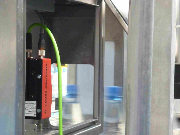 At Küppersbusch GmbH in Velbert (Germany), “bottle inspectors” have a camera control system based on the LSIS 412i smart camera from Leuze electronic. The camera allows the bottle inspector to check several features at the same time: whether labels are present, whether the filling quantities are correct and whether the bottles are sealed properly. With innovative and high-performance camera technology, LSIS 412i smart cameras make possible fast and simple quality assurance as well as identification. They provide all necessary components in the housing itself – from illumination to image processing, image and program memory, display, result display and interfaces. This makes them lightweight and easy to integrate in machine designs, even in tight installation spaces. Thanks to its industrial-grade, robust design, the LSIS 400i series is also ideally suited for the harsh – as well as usually humid – environment encountered in beverage production.
At Küppersbusch GmbH in Velbert (Germany), “bottle inspectors” have a camera control system based on the LSIS 412i smart camera from Leuze electronic. The camera allows the bottle inspector to check several features at the same time: whether labels are present, whether the filling quantities are correct and whether the bottles are sealed properly. With innovative and high-performance camera technology, LSIS 412i smart cameras make possible fast and simple quality assurance as well as identification. They provide all necessary components in the housing itself – from illumination to image processing, image and program memory, display, result display and interfaces. This makes them lightweight and easy to integrate in machine designs, even in tight installation spaces. Thanks to its industrial-grade, robust design, the LSIS 400i series is also ideally suited for the harsh – as well as usually humid – environment encountered in beverage production.
 Another good example of successful implementation is Apollinaris. There, the light scanners used in one of the beverage filling systems were replaced with LSIS 412i smart cameras from Leuze electronic. Thanks to these cameras, it is no longer necessary to change over any equipment if the product being scanned is changed, and they also ensure reliable detection of all label varieties.
Another good example of successful implementation is Apollinaris. There, the light scanners used in one of the beverage filling systems were replaced with LSIS 412i smart cameras from Leuze electronic. Thanks to these cameras, it is no longer necessary to change over any equipment if the product being scanned is changed, and they also ensure reliable detection of all label varieties.
 A further example of beverage filling would be Aqua Römer: In the past, complex inspection systems which work with different detection technologies were used for checking bottle tops in such filling facilities. Voigt Technology has developed a clever concept for Aqua Römer – based on the LSIS 412i smart camera, it is inexpensive and has an impressive detection performance achieving a throughput rate of 30,000 to 40,000 bottles per hour. By restricting BLOB features such as length, width, height, surface, shape factor or circumference, objects or object groups can be reliably detected and differentiated on the basis of their geometric features – even when other processes are supplying incorrect results.
A further example of beverage filling would be Aqua Römer: In the past, complex inspection systems which work with different detection technologies were used for checking bottle tops in such filling facilities. Voigt Technology has developed a clever concept for Aqua Römer – based on the LSIS 412i smart camera, it is inexpensive and has an impressive detection performance achieving a throughput rate of 30,000 to 40,000 bottles per hour. By restricting BLOB features such as length, width, height, surface, shape factor or circumference, objects or object groups can be reliably detected and differentiated on the basis of their geometric features – even when other processes are supplying incorrect results.
 The bottle cap is “searched” both horizontally and vertically with additionally-created test fields in order to then track the actual test fields accordingly. This effectively compensates position shifts and height tolerances for monitoring. All in all, the new monitoring system for tilted cap position is considerably more economical and easier to use than conventional solutions. It does not require any special settings and only negligible maintenance. The detection rate at Aqua Römer is 99.8 %.
The bottle cap is “searched” both horizontally and vertically with additionally-created test fields in order to then track the actual test fields accordingly. This effectively compensates position shifts and height tolerances for monitoring. All in all, the new monitoring system for tilted cap position is considerably more economical and easier to use than conventional solutions. It does not require any special settings and only negligible maintenance. The detection rate at Aqua Römer is 99.8 %.



